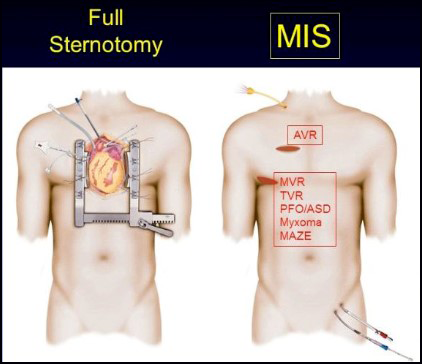If you need to have heart surgery, you want to know that you’re in the best hands using the latest techniques. At Rochester Regional Health’s Sands-Constellation Heart Institute, we’re home to some of the nation’s leading cardiac surgeons in using minimally invasive techniques to repair even the most complicated heart issues. In fact, Rochester General Hospital is one of the only two centers in upstate New York where minimally invasive heart surgery is conducted.
The Key to a Quicker Recovery from Heart Surgery
Minimally invasive heart surgery (MIS), also known as keyhole surgery, is a procedure that an expert heart surgeon uses to repair your heart through small incisions without having to “crack the chest” or, split the breastbone.
While splitting the breastbone might sound intimidating, there are some cases when it is necessary. When it’s not, our surgeons aim to use the techniques that will get you the best possible outcomes with fewer side effects.
What are the Benefits of MIS Heart Surgery?
During minimally invasive heart surgery, the surgeon uses small incisions and specialized instruments and scopes to perform the procedure. As documented by published research, this results in:
- Less pain and trauma
- Quicker recovery and shorter hospital stay
- Lower infection rate
- Lower risk of pneumonia
- Smaller incision and scar
- Less blood loss
- A better view of certain parts of the heart, giving the surgeon critical information for a more comprehensive operation
When is MIS Heart Surgery Used?
Minimally invasive cardiac valve surgery (MIVS) is a procedure performed for repairing or replacing heart valves through a small incision under direct vision. Minimally invasive heart surgery may be performed to treat a variety of heart valves, congenital, arrhythmia and heart failure conditions including:
- Mitral Valve Regurgitation and Stenosis (Mitral Valve Repair or Replacement)
- Tricuspid Valve Regurgitation and Stenosis (Tricuspid Valve Repair and Replacement)
- Aortic Valve Regurgitation and Stenosis (Aortic Valve Repair and Replacement)
- Double Valvular Disease (Combined Mitral and Tricuspid Repair or Replacement)
- Atrial Septal Defect and Patent Ductus Ovale (Surgical Closure)
- Atrial Fibrillation (Biatrial Maze IV or Total Thoracoscopic Hybrid Maze with radiofrequency and cryoprecipitate)
- Atrial Mxyoma (Resection)
- Congestive Heart Failure (MIS LVAD placement)

